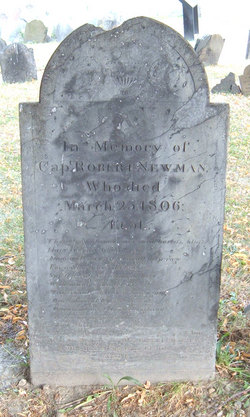Capt. Robert Newman, Freemason
I’m seeking to distinguish the two men named Robert Newman who lived in the North End and died two years apart in 1804 and 1806.
According to the records of the St. John’s Lodge of Freemasons in Boston, a Robert Newman became a member in 1783. At the end of 1792 he was chosen to be one of the “Toilers for the ensuing year.”
In 1790 a new Masonic lodge was founded in Newburyport. Four years later, those Freemasons conferred the higher title of “Knight Templar” on Robert Newman.
I’m convinced both these items refer to Capt. Robert Newman, the mariner who commanded a privateer during the Revolutionary War. He had a house in Boston in the mid-1780s and a family in Newbury by 1790. As a ship’s captain he was of the right socioeconomic class to join a Masonic lodge in that period.
The mariner’s early-1800s gravestone at the Copp’s Hill Burying Ground displays Masonic emblems (above the word “Memory”). That stone reads:
According to the records of the St. John’s Lodge of Freemasons in Boston, a Robert Newman became a member in 1783. At the end of 1792 he was chosen to be one of the “Toilers for the ensuing year.”
In 1790 a new Masonic lodge was founded in Newburyport. Four years later, those Freemasons conferred the higher title of “Knight Templar” on Robert Newman.
I’m convinced both these items refer to Capt. Robert Newman, the mariner who commanded a privateer during the Revolutionary War. He had a house in Boston in the mid-1780s and a family in Newbury by 1790. As a ship’s captain he was of the right socioeconomic class to join a Masonic lodge in that period.
The mariner’s early-1800s gravestone at the Copp’s Hill Burying Ground displays Masonic emblems (above the word “Memory”). That stone reads:
In Memory ofThe other Robert Newman living in Boston’s North End until 1804 was unlikely to have been a Freemason, I believe. He was a church sexton, a profession then associated with poverty. He didn’t command genteel authority in that society. But through the quirks of history, Newman the sexton has been posthumously made a Mason.
Capt. ROBERT NEWMAN,
Who died
March 23, 1806;
Æt. 51.
Though Neptune’s waves and Boreas’ blasts
Have tossed me to and fro,
Now well escaped from all their rage,
I’m anchored here below.
Safely I’ll ride in triumph here,
With many of our fleet,
Till signals call to weigh again,
Our Admiral Christ to meet.
O may all those I’ve left behind
Be washed in Jesus’ blood,
And when they leave this world of sin
Be ever with their Lord.
ALSO IN MEMORY OF CAPT. ROBERT NEWMAN, JUN.
WHO DIED AT SEA Dec. 14, 1816.


4 comments:
Thank you John, I am about to do a talk about April 19 and Freemasons and this is one myth that I will not share. I appreciate your work and I hope to see you soon.
All the best,
Sean Kelleher
Historian Saratoga, NY
Hi J.L.,
Robert Newman, the sexton, is also buried in Copp's Hill up against the far barrier of the burying grounds. The tombstone has multiple Masonic symbols including the letter G, square, and compass. There may be a need for further research into this matter to draw a definitive conclusion. I believe both Newman's were Masons and deep into the Masonic community at that.
Respectfully submitted,
Jude Kalaora
https://www.loc.gov/resource/det.4a11387/
to see his grave.
Yes, I discussed the sexton Robert Newman’s gravestone, which appears to have been put up around 1900, the day after this posting. I think the stone reflects confusion between the two men of the same name, one definitely a Freemason and the other celebrated after the Centennial.
Post a Comment